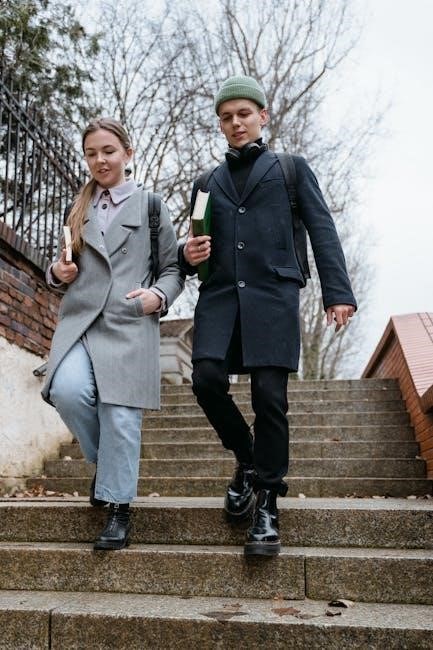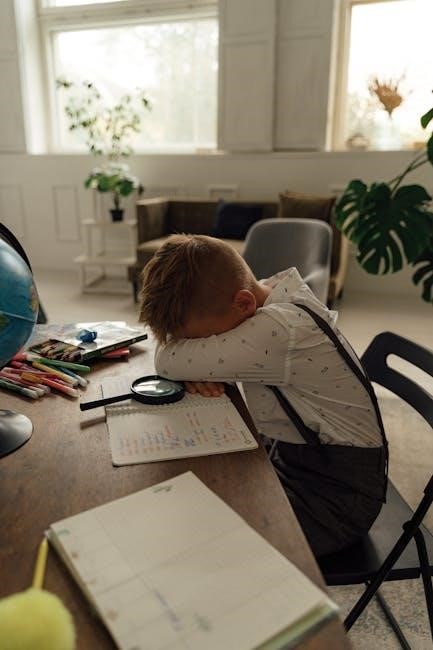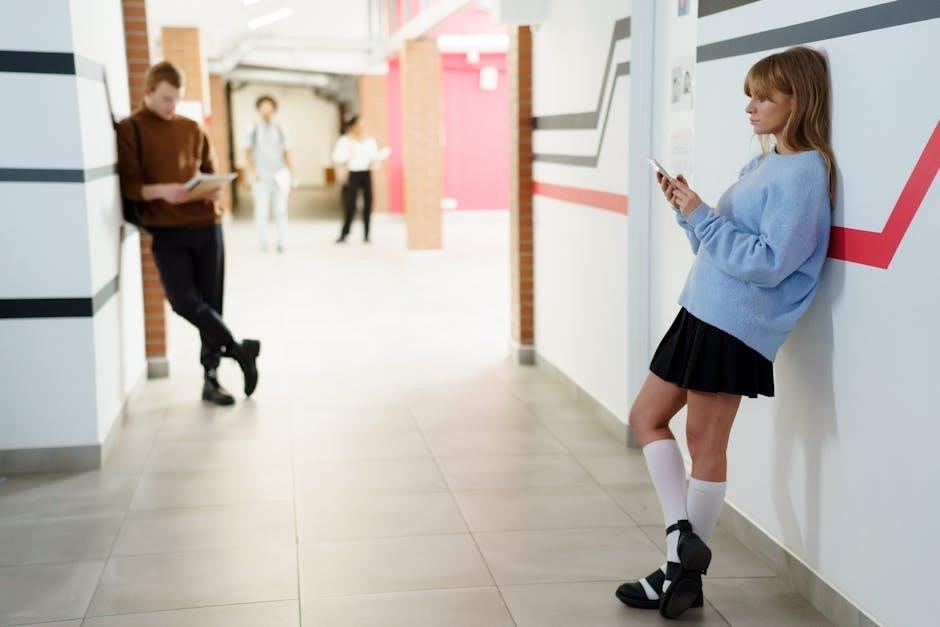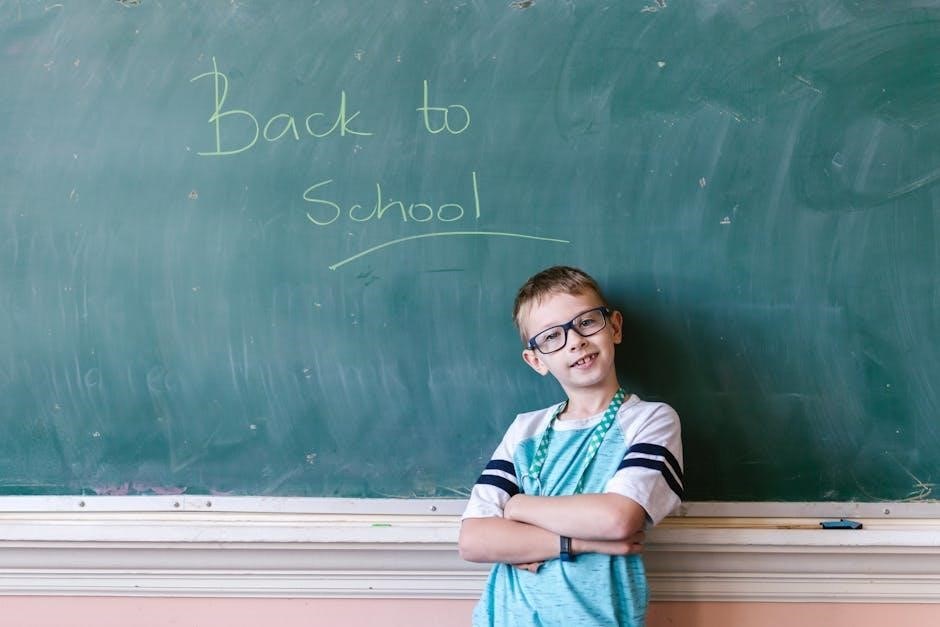The first day of school is crucial for setting the tone, building connections, and establishing routines. It’s a time to create a welcoming environment, introduce classroom expectations, and engage students with fun activities like scavenger hunts and icebreakers while providing essential resources and worksheets to ease transitions. Proper preparation ensures a smooth start, helping both teachers and students feel confident and excited for the academic year ahead. This section explores the significance of the first day, common activities, and practical tips for making it memorable and productive. By focusing on creativity, organization, and inclusivity, educators can lay a strong foundation for the entire school year. Effective planning and engagement strategies are key to fostering a positive classroom atmosphere from day one.
1.1 Importance of the First Day
The first day of school is foundational for setting the tone, building connections, and establishing routines. It provides an opportunity to create a welcoming environment, introduce classroom expectations, and engage students with fun activities like scavenger hunts and icebreakers. A positive first day boosts students’ confidence and excitement for learning. It also allows teachers to assess students’ interests, abilities, and needs, enabling tailored instruction. Practical resources such as worksheets and checklists help ease transitions and ensure organization. A well-organized first day fosters a sense of safety and belonging, laying a strong foundation for the academic year. By prioritizing engagement, creativity, and inclusivity, educators can create a memorable and productive start that benefits both students and teachers.
1.2 Common Activities and Expectations
Common first-day activities include icebreakers like scavenger hunts, BINGO, and “Would You Rather” questions to foster connections. Teachers often introduce classroom rules, expectations, and routines, while students complete “All About Me” worksheets to share interests and goals. Group games like “I Have, Who Has?” encourage collaboration and interaction. Many classrooms incorporate word puzzles and homework agendas to establish organizational habits. Teachers also use name tag glyphs and compliment notes to promote inclusivity and positivity. Expectations include practicing transitions, such as lining up, and setting clear communication channels with parents. The day often ends with a review of key points and a clean-up routine. These activities help students feel comfortable, build camaraderie, and set the stage for a productive year. They balance fun with structure, ensuring a smooth transition into the academic environment.
1.3 Preparing for the First Day
Preparing for the first day involves organizing the classroom, planning engaging activities, and gathering essential materials. Teachers often use checklists to ensure everything is ready, from setting up desks to preparing printables like “All About Me” worksheets and word puzzles. Digital resources, such as printable PDFs and icebreakers, are also organized in advance. Classroom rules and expectations are drafted using templates to ensure clarity. Additionally, activities like scavenger hunts and BINGO require preparation to ensure smooth execution. Teachers may also prepare take-home folders and parent-teacher communication templates to keep families informed. Organizing lesson plans, decorating the classroom, and setting up interactive games like “I Have, Who Has?” are key steps. Proper preparation helps create a welcoming environment, reduces first-day jitters, and sets the tone for a successful academic year. These efforts ensure a structured yet engaging start for students and teachers alike.

Icebreaker Activities for the First Day

Engage students with fun icebreakers like scavenger hunts, BINGO, and “Would You Rather” questions to foster connections and ease first-day nerves. These activities encourage interaction and build a positive classroom atmosphere. Compliment notes and name tag glyphs also help students share about themselves, promoting inclusivity and teamwork. Digital icebreakers and interactive games like “Two Truths and a Lie” further enhance participation, making the first day memorable and enjoyable for all. These activities are designed to help students feel comfortable and excited about the new academic year. By incorporating these creative and interactive exercises, teachers can create a welcoming environment that encourages collaboration and curiosity from the very start. These icebreakers are essential for setting a positive tone and helping students and teachers get to know one another. They also provide a foundation for building strong classroom relationships and a sense of community. With these activities, the first day becomes a fun and engaging experience that laid the groundwork for a successful year ahead. Additionally, they allow teachers to assess students’ personalities, interests, and communication skills, which is invaluable for personalized instruction. Overall, icebreakers are a crucial part of making the first day of school a positive and memorable experience for everyone involved. By incorporating a variety of activities, teachers can cater to different learning styles and ensure that all students feel included and valued. This approach not only reduces anxiety but also fosters a sense of belonging, which is essential for academic success. With careful planning and execution, these activities can set the stage for a productive and enjoyable school year. They provide a platform for students to express themselves, share their thoughts, and begin forming meaningful connections with their peers. Moreover, they offer a glimpse into students’ abilities and interests, helping teachers tailor their instruction to meet individual needs. By making the first day engaging and interactive, teachers can create a lasting impression and inspire a love for learning that will last throughout the year. These activities are a key component of a successful first day, laying the foundation for a year filled with growth, discovery, and achievement. Through these icebreakers, teachers can create a supportive and inclusive classroom environment where every student feels valued and empowered to succeed. By prioritizing engagement and connection, educators can set their students up for a year of academic and personal growth. These activities are more than just games; they are tools for building relationships, fostering creativity, and establishing a positive classroom culture. They provide a way for teachers to connect with their students on a personal level, understanding their unique perspectives and strengths. By doing so, teachers can create a learning environment that is both challenging and supportive, where every student has the opportunity to thrive. Ultimately, the first day of school sets the tone for the entire year, and these icebreakers play a vital role in making it a day to remember. They help ease transitions, reduce anxiety, and create a sense of excitement and anticipation for the year ahead. With a well-planned and executed icebreaker session, teachers can ensure that their students are prepared to embark on a journey of learning and discovery. These activities are a powerful way to break down barriers, build connections, and create a sense of community in the classroom. By incorporating them into the first day, teachers can set their students up for success and lay the groundwork for a positive and productive school year. The benefits of these activities extend far beyond the first day, influencing the overall classroom dynamics and student engagement throughout the year. They provide a foundation for open communication, collaboration, and mutual respect, which are essential for a thriving learning environment. With these icebreakers, teachers can create a classroom where every student feels seen, heard, and valued, paving the way for a year filled with growth and achievement. The first day is a fresh start, and these activities help make it a memorable and impactful one. They allow teachers to connect with their students, understand their needs, and create a personalized learning experience that addresses their unique strengths and challenges. By prioritizing connection and engagement, educators can ensure that their students are well-prepared to succeed in the days and weeks ahead. These icebreakers are a vital part of creating a positive and inclusive classroom culture, setting the stage for a successful and fulfilling school year. Through these activities, teachers can build strong relationships with their students, foster a sense of community, and create a learning environment that is both supportive and stimulating. They are an essential tool for making the first day of school a positive and memorable experience for everyone involved. The benefits of these activities are immeasurable, as they help establish a strong foundation for the entire school year. By incorporating them into the first day, teachers can create a classroom where students feel comfortable, confident, and ready to learn. These icebreakers are more than just activities; they are a way to connect, inspire, and empower students to reach their full potential. They provide a way for teachers to create a positive and engaging classroom environment that fosters growth, creativity, and collaboration. With these activities, the first day of school can be a day of discovery, connection, and excitement, setting the tone for a successful and rewarding year. The first day is an opportunity to make a lasting impression, and these icebreakers help teachers do just that. By making the first day interactive and enjoyable, teachers can inspire their students to embrace the year ahead with enthusiasm and curiosity. These activities are a key part of creating a positive and supportive classroom culture, ensuring that every student feels valued and empowered to succeed. They provide a way for teachers to connect with their students, understand their needs, and create a personalized learning experience that addresses their unique strengths and challenges. By prioritizing connection and engagement, educators can ensure that their students are well-prepared to succeed in the days and weeks ahead. These icebreakers are a vital part of creating a positive and inclusive classroom culture, setting the stage for a successful and fulfilling school year. Through these activities, teachers can build strong relationships with their students, foster a sense of community, and create a learning environment that is both supportive and stimulating. They are an essential tool for making the first day of school a positive and memorable experience for everyone involved. The benefits of these activities are immeasurable, as they help establish a strong foundation for the entire school year. By incorporating them into the first day, teachers can create a classroom where students feel comfortable, confident, and ready to learn. These icebreakers are more than just activities; they are a way to connect, inspire, and empower students to reach their full potential. They provide a way for teachers to create a positive and engaging classroom environment that fosters growth, creativity, and collaboration. With these activities, the first day of school can be a day of discovery, connection, and excitement, setting the tone for a successful and rewarding year. The first day is an opportunity to make a lasting impression, and these icebreakers help teachers do just that. By making the first day interactive and enjoyable, teachers can inspire their students to embrace the year ahead with enthusiasm and curiosity. These activities are a key part of creating a positive and supportive classroom culture, ensuring that every student feels valued and empowered to succeed. They provide a way for teachers to connect with their students, understand their needs, and create a personalized learning experience that addresses their unique strengths and challenges. By prioritizing connection and engagement, educators can ensure that their students are well-prepared to succeed in the days and weeks ahead. These icebreakers are a vital part of creating a positive and inclusive classroom culture, setting the stage for a successful and fulfilling school year. Through these activities, teachers can build strong relationships with their students, foster a sense of community, and create a learning environment that is both supportive and stimulating. They are an essential tool for making the first day of school a positive and memorable experience for everyone involved. The benefits of these activities are immeasurable, as they help establish a strong foundation for the entire school year. By incorporating them into the first day, teachers can create a classroom where students feel comfortable, confident, and ready to learn. These icebreakers are more than just activities; they are a way to connect, inspire, and empower students to reach their full potential. They provide a way for teachers to create a positive and engaging classroom environment that fosters growth, creativity, and collaboration. With these activities, the first day of school can be a day of discovery, connection, and excitement, setting the tone for a successful and rewarding year. The first day is an opportunity to make a lasting impression, and these icebreakers help teachers do just that. By making the first day interactive and enjoyable, teachers can inspire their students to embrace the year ahead with enthusiasm and
2.1 Classroom Scavenger Hunt

A classroom scavenger hunt is a dynamic and engaging icebreaker activity that encourages students to explore their new environment while interacting with peers. Teachers create a list of items or questions related to the classroom or school, such as locating specific supplies, identifying classroom rules, or finding someone who shares a hobby. Students work individually or in groups to complete the tasks, fostering teamwork and problem-solving skills. This activity not only helps students familiarize themselves with the classroom layout but also introduces them to classmates in a fun and collaborative way. It’s an excellent way to ease first-day jitters, promote active learning, and set a positive tone for the academic year. The scavenger hunt also allows teachers to observe students’ personalities and communication styles, providing valuable insights for future lessons. By incorporating creativity and movement, this activity ensures a memorable and enjoyable start to the school year. It’s a simple yet effective strategy to build connections and create a sense of belonging among students. The classroom scavenger hunt is a versatile activity that can be tailored to different age groups and classroom settings, making it a popular choice for educators. Its interactive nature helps students feel comfortable in their new environment while laying the groundwork for a collaborative and inclusive classroom culture. This activity is more than just a game; it’s a tool for fostering engagement, curiosity, and camaraderie from day one. By encouraging exploration and interaction, the scavenger hunt helps students transition smoothly into the new school year with confidence and enthusiasm. It’s a meaningful way to kick off the year, ensuring that every student feels welcomed and prepared for the adventures ahead. The classroom scavenger hunt is a timeless and adaptable activity that continues to be a favorite among teachers and students alike, offering countless benefits for both social and academic growth. Its success lies in its ability to combine learning with fun, creating a lasting impression on the first day of school. By participating in this activity, students not only learn about their surroundings but also develop essential social skills that will benefit them throughout the year. The classroom scavenger hunt is a powerful way to break the ice, build relationships, and create a positive classroom atmosphere, making it an indispensable part of the first-day agenda. Its impact extends beyond the initial activity, contributing to a stronger sense of community and cooperation in the classroom. By prioritizing engagement and interaction, teachers can ensure that their students are well-prepared to succeed in the days and weeks ahead. The classroom scavenger hunt is a simple yet profound way to make the first day of school a memorable and impactful experience for everyone involved.
2.2 First Day BINGO
First Day BINGO is a popular and engaging icebreaker activity designed to help students get to know each other on the first day of school. Teachers create BINGO cards with different traits, hobbies, or fun facts, such as “has a pet” or “loves reading.” Students circulate around the classroom, interviewing peers to find someone who fits each description, and get them to sign the corresponding square. This activity encourages interaction, breaks the ice, and helps students feel more comfortable in their new environment. It also fosters teamwork and communication skills while adding an element of fun to the first day. The BINGO game can be tailored to different age groups and classroom dynamics, making it a versatile and effective tool for building connections. By participating, students begin to form friendships and establish a sense of community, which is essential for a successful school year.

2.3 “Would You Rather” Questions
“Would You Rather” questions are a fun and interactive way to spark conversations and help students get to know one another on the first day of school. Teachers can create a list of thought-provoking questions, such as “Would you rather go on a safari or explore a new city?” or “Would you rather have a lifetime supply of your favorite snack or be able to travel anywhere for free?” Students share their preferences and explain their reasoning, fostering creativity and critical thinking. This activity encourages participation from all students, breaking the ice and creating a relaxed atmosphere. It also allows teachers to gain insights into students’ interests and personalities, helping to build connections. By incorporating “Would You Rather” into the first day, educators can create engaging and memorable experiences while promoting collaboration and self-expression. This activity is simple to implement and adaptable to various age groups, making it a valuable tool for fostering classroom community.
2.4 Two Truths and a Lie
Two Truths and a Lie is a popular icebreaker activity that encourages students to share interesting facts about themselves while others guess which statement is false. Each student presents two true statements and one false statement about themselves, such as hobbies, pets, or unique experiences. This activity sparks curiosity, laughter, and engagement, helping to build connections among students and between students and teachers. It also fosters critical thinking as participants analyze clues to identify the lie. Teachers can adapt this game to fit different age groups, with younger students drawing pictures or writing simple sentences. By sharing personal stories, students feel more comfortable and develop a sense of belonging in the classroom. This activity is an effective way to create a fun and inclusive atmosphere on the first day of school, promoting teamwork and communication. It’s simple to organize and always leads to memorable moments.
2.5 Name Tag Glyph Activity
The Name Tag Glyph Activity is a creative way for students to introduce themselves on the first day of school. Each student receives a name tag with symbols or glyphs that represent different traits, such as hobbies, favorite colors, or pets. Students decorate their tags using markers, stickers, or drawings to visually express their personalities. This activity encourages students to share personal details in a non-verbal way, making it less intimidating for shy students. Teachers can then use the glyphs as conversation starters to help students connect with one another. For example, a picture of a cat might lead to a discussion about pets, while a favorite color could spark a conversation about preferences. This activity not only fosters creativity but also helps build classroom camaraderie and makes students feel welcomed and understood from the start. It’s a simple yet effective way to break the ice and create a positive classroom environment. By sharing their glyphs, students take their first steps toward forming meaningful relationships with their peers and teacher. This engaging and interactive approach ensures that everyone feels included and valued on the first day of school. Additionally, the name tags can be displayed in the classroom as a reminder of the diverse and unique individuals within the class. This activity is particularly useful for visual learners and those who prefer non-verbal forms of expression. Overall, the Name Tag Glyph Activity is a fun and thoughtful way to kick off the school year, promoting self-expression and connection among students. It also provides teachers with insights into their students’ interests and personalities, helping to tailor instruction and build rapport. The activity is versatile and can be adapted to suit different age groups and classroom settings, making it a valuable tool for educators seeking to create a welcoming and inclusive learning environment. By encouraging creativity and self-expression, this activity sets the stage for a positive and engaging academic year. It allows students to showcase their individuality while fostering a sense of community and belonging in the classroom. The Name Tag Glyph Activity is an excellent way to make the first day of school memorable and meaningful for everyone involved.
2.6 Compliment Notes
Compliment Notes is a heartwarming activity that fosters kindness and positivity on the first day of school. Each student receives a small piece of paper or a sticky note and writes a genuine compliment for a classmate. The notes can be about someone’s smile, personality, or even their choice of outfit. Students then exchange the notes, creating a ripple of positivity in the classroom. This activity helps break the ice, encourages social interaction, and makes students feel valued. It also teaches the importance of kindness and respect. Teachers can guide the process by modeling examples and ensuring compliments are sincere. Displaying the notes in the classroom or compiling them into a “Compliment Jar” can reinforce the positive atmosphere. This simple yet meaningful activity sets a tone of empathy and inclusivity, helping students feel connected and confident as they begin the school year. It’s a powerful way to build a supportive classroom community. Additionally, it allows students to reflect on the impact of their words and fosters a culture of appreciation. By starting the year with Compliment Notes, teachers can create a foundation of kindness that lasts throughout the school year. This activity is both engaging and uplifting, making it a great way to ease first-day jitters and promote camaraderie. It also provides a unique opportunity for students to practice social skills and understand the value of positive interactions. Overall, Compliment Notes is a simple yet impactful way to create a welcoming and supportive learning environment. It ensures that every student feels seen, heard, and appreciated from day one.

Worksheets and Printables for the First Day
Engage students with fun and educational worksheets designed for the first day of school. Activities like “All About Me,” friendship games, and word puzzles help students feel valued and allow teachers to assess abilities early. These resources are flexible and adaptable for various classroom settings, ensuring a smooth transition into the new academic year while fostering creativity and interaction. Printables like homework agendas and “I Have, Who Has?” games promote organization and teamwork, making the first day both productive and enjoyable for everyone.
3.1 All About Me Worksheet
The “All About Me” worksheet is a popular activity for the first day of school, designed to help students share personal details about themselves. This worksheet typically includes sections for students to write their name, age, favorite color, hobbies, and goals for the school year. It also encourages them to draw or describe their interests, making it a creative way for students to express themselves. Teachers can use this tool to gain insights into their students’ personalities, interests, and learning styles, which helps in tailoring instruction to meet individual needs. The worksheet fosters a sense of belonging and makes students feel valued from the very start. Additionally, it serves as a fun icebreaker, allowing classmates to learn about one another and build connections. Over time, it can also serve as a keepsake to track growth throughout the year.

3.2 Friendship Game Worksheet
The Friendship Game Worksheet is a thoughtful activity designed to help students connect with one another on the first day of school. This worksheet typically includes prompts or questions that encourage students to share interests, hobbies, or experiences, fostering mutual understanding and camaraderie. For example, students might answer questions like, “What’s your favorite activity to do with friends?” or “What’s something unique about you?” This activity not only breaks the ice but also helps students identify common interests, laying the groundwork for meaningful friendships. Teachers can use this worksheet to create a positive classroom environment, promote collaboration, and ensure that every student feels included. It’s a simple yet effective way to build social connections and set a friendly tone for the school year. Additionally, it complements other icebreaker games, making it a versatile resource for educators.

3.3 Word Puzzles
Word puzzles are an engaging and educational activity for the first day of school, designed to captivate students while helping them relax and familiarize themselves with the classroom environment. These puzzles often include word searches, crosswords, or anagrams that incorporate vocabulary related to school, friendship, or classroom themes. They serve as a fun way to introduce students to key terms and concepts while encouraging teamwork and problem-solving skills. Many word puzzles are adaptable to different grade levels, ensuring they suit the abilities of all students. Teachers can also customize them to align with specific themes or subjects, making them a versatile tool for icebreaking and learning. Additionally, word puzzles provide a subtle way to assess students’ language skills and creativity, offering insights into their strengths and areas for growth. This activity fosters a sense of accomplishment and shared experience, helping to build a positive classroom atmosphere.
3.4 Homework Agenda
A homework agenda is a practical and essential tool for the first day of school, helping students and parents stay organized and informed. These agendas typically include a weekly or daily schedule, sections for listing assignments, due dates, and space for notes between teachers and parents. They are designed to promote time management, responsibility, and clear communication. Many homework agendas are customizable, allowing teachers to tailor them to their specific classroom needs and teaching styles. By introducing the homework agenda on the first day, teachers can set expectations for the year, ensuring students understand the importance of staying on top of their work. This resource also serves as a bridge between school and home, keeping families involved in their child’s education and helping students develop strong organizational habits from the very beginning. It’s a simple yet effective way to foster accountability and prepare students for academic success.
3.5 “I Have, Who Has?” Activity
The “I Have, Who Has?” activity is a popular and engaging icebreaker for the first day of school. It’s designed to help students get to know one another while encouraging participation and interaction. Teachers create cards or slips of paper with questions or statements (e.g., “I have a pet,” “I have traveled to another country,” or “I have a sibling”). Students take turns drawing a card and sharing something about themselves. The activity fosters collaboration and builds a sense of community, making it easier for students to connect with peers who share similar interests or experiences. This game also helps teachers learn more about their students in a fun and relaxed manner, setting a positive tone for the year. It’s a simple yet effective way to break the ice and create a welcoming classroom environment.

Checklists and Templates
Checklists and templates are essential tools for organizing the first day of school. They help teachers prepare materials, establish rules, and communicate effectively with parents. These resources ensure a smooth start to the academic year by covering all necessary tasks and expectations.

4.1 Teacher Preparation Checklist
A comprehensive teacher preparation checklist ensures a smooth start to the school year. Organize classroom setup, prepare teaching materials, and plan engaging lessons. Review school policies, update parent communication templates, and prepare icebreaker activities. Ensure all necessary supplies are stocked, and technology is ready for use. Create a seating chart, establish classroom rules, and prepare homework agendas. Review student records, plan introductory activities, and set clear expectations. Distribute welcome packets, prepare name tags, and schedule a classroom tour. Finally, reserve time for cleaning and reviewing the day’s events. This checklist helps teachers feel confident and prepared, setting a positive tone for the year. By covering all bases, educators can focus on connecting with students and fostering a productive learning environment from day one.
